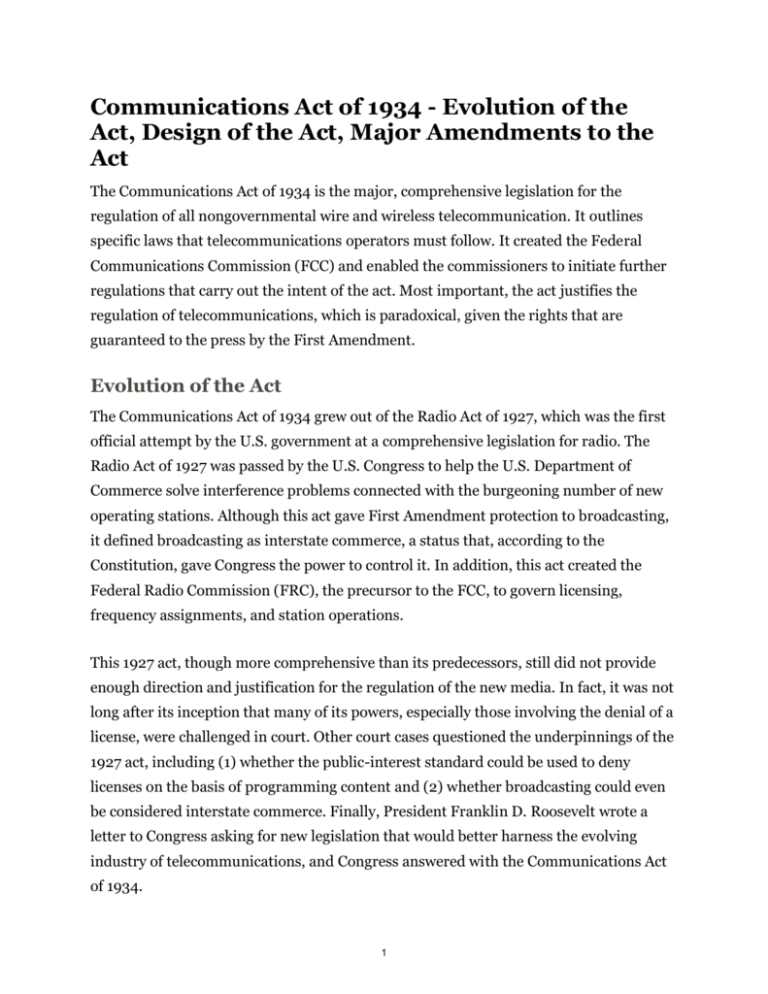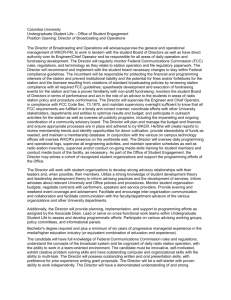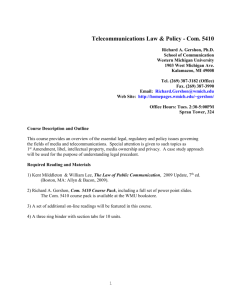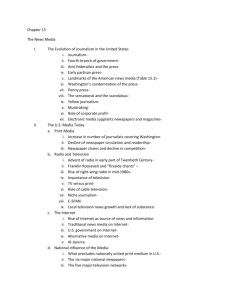Communications Act of 1934 - Evolution of the Act, Design of the Act
advertisement

Communications Act of 1934 - Evolution of the Act, Design of the Act, Major Amendments to the Act The Communications Act of 1934 is the major, comprehensive legislation for the regulation of all nongovernmental wire and wireless telecommunication. It outlines specific laws that telecommunications operators must follow. It created the Federal Communications Commission (FCC) and enabled the commissioners to initiate further regulations that carry out the intent of the act. Most important, the act justifies the regulation of telecommunications, which is paradoxical, given the rights that are guaranteed to the press by the First Amendment. Evolution of the Act The Communications Act of 1934 grew out of the Radio Act of 1927, which was the first official attempt by the U.S. government at a comprehensive legislation for radio. The Radio Act of 1927 was passed by the U.S. Congress to help the U.S. Department of Commerce solve interference problems connected with the burgeoning number of new operating stations. Although this act gave First Amendment protection to broadcasting, it defined broadcasting as interstate commerce, a status that, according to the Constitution, gave Congress the power to control it. In addition, this act created the Federal Radio Commission (FRC), the precursor to the FCC, to govern licensing, frequency assignments, and station operations. This 1927 act, though more comprehensive than its predecessors, still did not provide enough direction and justification for the regulation of the new media. In fact, it was not long after its inception that many of its powers, especially those involving the denial of a license, were challenged in court. Other court cases questioned the underpinnings of the 1927 act, including (1) whether the public-interest standard could be used to deny licenses on the basis of programming content and (2) whether broadcasting could even be considered interstate commerce. Finally, President Franklin D. Roosevelt wrote a letter to Congress asking for new legislation that would better harness the evolving industry of telecommunications, and Congress answered with the Communications Act of 1934. 1 Design of the Act The Communications Act of 1934 acknowledges the First Amendment status of broadcasting, yet it also provides a rationale for regulation despite this status. This rationale is built on the premise that telecommunication operators must act “in the public interest, convenience, and necessity.” The reason for this is twofold. First, the airwaves are considered to be a publicly owned natural resource. Therefore, as with any scarce resource, the government is entitled to ensure that this public property is used as a public service. The second part of this rationale argues that, because the airwaves are publicly owned, the operators of electronic media act not as owners but as trustees of the frequencies they use, thereby functioning as the public’s proxy when managing this public resource. This rationale serves to justify the provisions of the act itself, but it also justifies electronic media regulation by the FCC beyond basic technological regulation. The first paragraph of the act establishes the FCC as the independent regulatory agency that is charged with carrying out the intent of Congress and the act. Through this establishment, the act becomes the enabling legislation for the FCC, dictating the organization, enforcement measures, and procedural methods that the FCC must follow. Other sections of the act provide principles and initiatives that require specific regulatory action from the FCC in order to be implemented. For example, sections 303(o) and 303(p) of the act allow the FCC to assign call letters to stations and require that the stations publish “such call letters and other such announcements and data as in the judgment of the Commission… for the efficient operation…” of these stations. The latter part of this allowance entitled the FCC to create rule 73.1201, which requires stations to identify themselves during sign-on, sign-off, and natural breaks at every hour. This identification must include their call letters, the location in which they are licensed, and, for radio stations, their frequency. In this manner, the act empowers the FCC to create and execute rules, policies, and regulations based on the directives of the act. Conjointly, the act also contains explicit regulations that the FCC must enforce. A prime example of this is found in the political communication provisions of section 315. Section 315, among other requirements, prohibits broadcast and cable operators from 2 censoring the content of any political message. This means that broadcasters and cable operators cannot censor political advertisements, nor can the FCC ban a political spot based on questionable content. It is important to note, however, that although section 315 prohibits the banning of a political spot on the basis of content, even political messages are subject to the indecency and obscenity laws of the U.S. Criminal Code (section 1464) and to the First Amendment tests for “clear and present danger” (as set forth in Schenck v. United States , 1919; United States v. O’Brien , 1968; and Preferred Communications v. City of Los Angeles , 1989). Nevertheless, this statute exemplifies one of the many explicit regulations of the act that must be enforced by the FCC. Major Amendments to the Act Similar to the U.S. Constitution, the Communications Act of 1934 has had to evolve to accommodate new technologies and to ensure that the new and existing technologies were serving the public interest. In order to accomplish this, elements of certain sections were altered, expanded, or abolished in order to update the usefulness of the act. Also, from time to time, laws have been passed that added entire sections to the act. These sections were specific to particular areas of telecommunication, and they gave the FCC additional power and responsibilities. One such modification to the Communications Act of 1934 is the Communications Satellite Act of 1962, which was enacted to regulate the long-term commercial use of satellites. This act created the Communications Satellite Corporation (COMSAT) to oversee this commercial use. That same year, the All Channel Receiver Act was passed to require all television receivers to receive both VHF and the new UHF signals, and the Educational Television Facilities Act was enacted to provide money for the construction of educational stations. The Educational Television Facilities Act of 1962 paved the way for the Public Broadcasting Act of 1967, which provided the first direct appropriation for noncommercial programming. More notably, it established the Corporation for Public Broadcasting, which has become the major founder of educational broadcasting facilities. 3 The next major legislation was the Cable Communications Policy Act of 1984. This act outlined the relationship between cable operator and local franchising authority as well as relaxed the franchise regulation of cable rates. However, the act was created during a time of deregulation, and it soon became apparent that the cable industry would need more conservative regulation. Thus, the Cable Television Consumer Protection and Competition Act of 1992 re-regulated cable by reevaluating the powers of the franchising authority over the cable operator, prohibiting exclusive program arrangements between cable operator and program supplier, and otherwise promoting competition. Another piece of legislation passed in the same decade was the Children’s Television Act of 1990. This act placed limitations on the amount of advertising as well as the use of advertising and other commercial acts during children’s programming. It also detailed specific requirements for children’s programming and made other suggestions on how communications operators could better serve the public interest. Finally, the Telecommunications Act of 1996 was enacted as the largest-ever addition to the Communications Act of 1934. It gave the FCC new initiatives and challenges in the face of digital broadcasting and other dawning technologies, and it outlined further public-interest responsibilities that communicators in the new digital era would be obliged to adopt. In sum, the Telecommunications Act of 1996 amended and added provisions to the 1934 act in an effort to promote electronic media competition, provide universal service, and ensure that all future electronic media will serve “the public interest, convenience, and necessity.” Strengths and Weaknesses of the Act The Communications Act of 1934 has been both praised and condemned for its various provisions and effects. One of its most notable strengths is its breadth in creating a single independent regulatory agency that has the power to regulate all electronic media. Likewise, the act can be admired for its design in that it includes the legislative, executive, and judicial branches of government in the execution and evaluation of its various provisions, similar to the laws establishing other regulatory agencies. A third strength is its interpretive quality in that it dictates initiatives that the FCC can interpret 4 and then execute according to contemporary needs. This interpretive quality, however, has also been regarded as a weakness when certain provisions have needed further clarification in order to be effectively adopted. Another criticism concerns the appointment method for filling commissioner positions, which leaves this process subject to political considerations that can take precedence over an appointee’s qualifications. A related concern is the potential for Congress to refrain from approving the appointment of any or all commissioners or to delay appropriating an operating budget in an attempt to influence the functioning of the FCC. However flawed the Communications Act of 1934 may be, its survival serves as a testament to its fundamental effectiveness. The act still stands as the first, and only, comprehensive regulatory legislation for all electronic media. It successfully solved the regulatory problems that were experienced by its predecessors, and it will continue to evolve with the evolving media, solving new problems as they arise. Additional Topics Organization of the Act The Communications Act of 1934 contains seven titles, or sections, each of which addresses a specific area of telecommunication. The first paragraph of Title I lays out the purpose of the act by first identifying wire and wireless communication as interstate and foreign commerce and then introducing the FCC as its regulatory enforcer. This first section also introduces the phrase ?in the public in… Communications Decency Act of 1996 - Legislative Development, Conclusion [next] [back] Communication Study The Roots of the Field, Speech and Journalism Emerge as Disciplines, Multidisciplinary Growth, Growth and Segmentation 5








